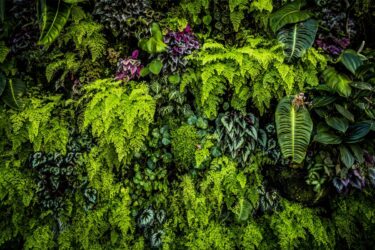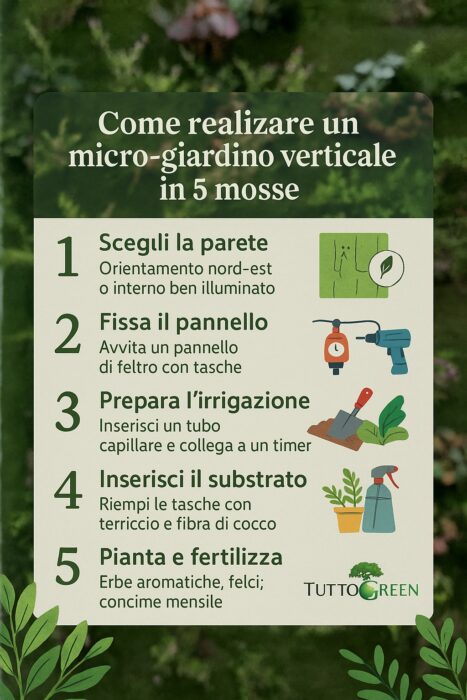
The Green walls (o vertical gardens) are the most green and effective to the problems that afflict modern cities. They offer natural protection from’noise pollution and from the smog, provide excellent insulation which allows energy saving for heating and cooling buildings and good fire resistance.
And not only that. The benefits that these particular 'coatings'’ natural can also ensure that they also touch the sphere of well-being, because their sight, instead of a concrete wall in the Jungle small town, Rest your eye and relax your mind, even increasing the value of the property! Let's find out more about them together.
How many types of green walls are there?
But let's take a closer look at what it is really. There are various types of green walls, all easily adaptable to any architectural surface and modular according to specific needs:
– Partial or total cladding of external facades
– Self-supporting walls
– Retaining walls
– Fences
Green walls can be made on Large panels or Assembleable modules, that integrate well with the characteristics of the wall and that guarantee the functionality of doors and windows.
Modern plant engineering aimed at the construction of green walls finds greater application in two types of system: the facade Ventilated, Ideal for covering the external walls of large buildings, and the Sound-absorbing walls, exclusively designed to ensure acoustic insulation and beautification of urban areas near airports, Road and motorway junctions, railways.
But let's see them in detail.
The ventilated façade
Among the most popular systems in terms of vertical greenery, It involves a construction technique of assembly of panels already complete with vegetation.
This has the undoubted advantage of guaranteeing the substitutability even a single panel. The settling period of the plants from the laying of the plant is about 12 months and generally growing media places to support the vegetation (with plants selected by nurserymen), ensure even water distribution and a green area all year round.
The panels are generally made of oxidized aluminum sheet with cell structure to accommodate plants and grooves to facilitate the flow of water.
The back side of the panels is blind, So no danger to moisture’ for the walls of the building. The modules, In addition, are fixed to the wall through a Aluminum grille that acts as a support, and resists humidity and atmospheric agents.
A space is left between the system and the wall (inner tube) to ensure ventilation and thermal-acoustic insulation. The plants are placed on a Polypropylene felt irrigating substrate which contains a nucleus of peat and expanded perlite, that is, a volcanic rock that retains moisture, recreating the’habitat Natural for plant growth, This is a technique, very common in the crop hydroponics.
Sound-absorbing barriers
They are barriers Self supporting, Mono or bif-steels, Particularly suitable for reducing noise and improving urban aesthetics near railway stations and motorways. In this case, the structure is supported by Steel uprights on which the panels already welded to the metal mesh are installed.
For filling are used very light substrates capable of retaining water in the best possible way and providing the necessary nutrients to all grafted plants.
The footprint that these structures entail is very minimal (13,3 cm thick for single-sided, 22 cm the bi-facial), which makes them easily adaptable to any type of surface and context.
Green walls: which plant species are most suitable
In the previous part, we talked about the advantages of a green wall and examined assembly techniques and types of systems, Now it remains to be understood which plant species are most suitable for a natural coating for buildings or acoustic barriers, what kind of maintenance they need and what are the construction costs.
As for plants, the choice almost always falls on low-maintenance varieties, that is, they require little care and sporadic interventions during the year.
Another important feature, must be ground cover, therefore Space for climbers, Bushes, shrubs and hanging plants.
As for lawn varieties, the most used can be divided into 2 Categories:
- variety Microtherms (grasses) because they resist the cold well but not the heat
- variety macrotherms (tare and couch grass) because they love hot climates and with low temperatures they lose color and enter vegetative rest and then 'green'’ in spring
However, The choice of essences must take into account several factors, among which the most important are the geographical area in which the building is located (Sun exposure, Windiness, orientation…), the water and flowering requirements of the essences and the type of plant and substrate used.
The vegetation must be laid in favorable environmental and climatic conditions and it will be important to follow its development and adaptation especially in the first 8-12 months from installation.
Irrigation and fertilization are the fundamental care for all varieties used in plant walls. To guarantee water and fertilizer, automatic systems incorporated in the systems themselves are often used, by means of collectors arranged horizontally at different levels of the wall.
These collectors are connected to Vertical riser tubes that run in height of the structure, distributing nutrients to all plants. If the system is equipped with a closed-loop irrigation system, The water used is rainwater, stored in collection tanks at the base of the wall.
What are the benefits of green walls
These vertical urban green systems have countless advantages for buildings and for man:
-
- Thermal insulation: act as an insulating layer, reducing heat loss in winter and overheating in summer, and this translates into lower energy consumption for heating and cooling, with consequent economic savings
- Sound insulation: absorb sound waves, reducing noise pollution from outside
- Façade protection: protect the façade of the building from the elements, like rain, wind and UV rays, Extending their life and reducing maintenance costs
- Improved air quality: Green walls and facades reduce urban pollution, helping to improve urban air quality, and reducing the exposure of the population to substances harmful to health
- Mitigation of the heat island effect: Thanks to plant evapotranspiration, temperatures in urban areas are reduced, mitigating the heat island effect
- Stormwater management: absorb part of the rainwater, reducing the load on sewer networks and the risk of flooding
- Increasing urban biodiversity: provide habitat for insects, Birds and other animal species, helping to increase urban biodiversity
- Stress reduction: Contact with nature has a positive effect on mental health, reducing stress and improving mood, improve the psychological well-being of citizens, promoting relaxation and concentration.
- Mitigation of the effects of climate change: help reduce urban heat island, mitigating the negative effects of heat waves on human health
 How to create a vertical micro-garden in 5 affected
How to create a vertical micro-garden in 5 affected
Working time ≈ 2 Hours – Budget: 60-120 € For 1 m²

Let's use the Felt pocket method”: It is the cheapest and most modular, Suitable for balconies and interior walls in bright shade.
| Step | What to do | Tips |
|---|---|---|
| 1. Choose the wall | Northeast orientation or well-lit interior. Avoid walls with leaks. |
Suitable wall, exhibition |
| 2. Secure the panel | Screw a felt board with pockets to the wall (60 × 100 Cm). Leaves 2 cm of inner tube to prevent condensation. |
vertical pockets, modular substrate |
| 3. Prepare watering | Insert a capillary tube from 6 mm at the top; Connects to a timer to 2 min per day. |
drip irrigation |
| 4. Insert the substrate | Fill each pocket with ⅔ Universal potting soil + ⅓ coco coir; Add Perlite to Drain. |
Light substrate, Neutral pH |
| 5. Plant and fertilize | Recommended plants: ferns, Pothos,, Tradescantia, herbs. Spray organic fertilizer every 30 Gg. |
Shade plants, Easy maintenance |
 Basic maintenance: prunes excesses 1 time/month, adjust the timer according to the season and check the pH (5,5 – 6,5).
Basic maintenance: prunes excesses 1 time/month, adjust the timer according to the season and check the pH (5,5 – 6,5).
How much does a green wall cost?
But How much you spend for all this? There are many factors that determine the final price: Materials used for the structure, irrigation system, substrate, Essences. By way of example, it is sufficient to consider that for a green façade of 2 Meters high, equipped with irrigation tanks and aluminum support structures, the cost is around 420-450 euro per square meter.
We can say that a cost range updated to 2025 it is 80-500 €/m² for indoor modular solutions and 250-600 €/m² for external facades, taking as a reference the estimates published by sector portals
We will now refer to an indoor installation.
Depending on the size of the project, The cost of an internal green wall varies from 250 to 2.100 euro per sqm, including supply and installation costs.
For optimal installation for plant well-being and aesthetic creation, Seek professional advice.
Attention: the Green Bonus is no longer extended from 1° January 2025, but the expenses 2020-2024 remain deductible (36 %)
Green Walls Videos
Here is a recent installation in Piazza San Babila in Milan.
And to finish an all-natural green wall in this video from our Youtube channel.
FAQs about green walls and vertical gardens
Here are some answers to very common questions about this particular type of garden.
-
How long does a green wall last?
With regular maintenance it can exceed 20 years; The waterproof membrane must be checked every 5. -
A lot of water is needed?
No: with drip irrigation consumes on average 2-4 l/m² per day, half of a traditional lawn. -
Which plants do well in the shade?
Boston ferns, Pothos, asplenium, Calatea and Peperomia are ideal for exhibitions < 1 000 lux. -
Expenses can be deducted in the 2025?
The Green Bonus has not been renewed; only expenses incurred by 31 December 2024. -
What maintenance does it require?
Quarterly pruning, Weekly irrigation control and monthly organic fertilization. -
What is the average cost per m?²?
Indoor DIY: 80-150 €/m²; Professional outdoor façade: 250-600 €/m² (prices 2025).
Other insights
You may also be interested in these articles:
- All About Hanging gardens
- Guide to balcony plants
- The vertical garden: The best examples and techniques of this solution to make the city green
- How to make a vegetable garden on the terrace
- Mini indoor gardens: The new frontier of home gardening
- Alla scoperta dei giardini notturni, A green space that comes to life at night
- Giardino alla francese: lo schema rigoroso diventa un pò barocco
- Alla scoperta delle meraviglie del giardino all’italiana
- Cos’è una barriera acustica verde per le strade
Last updated on 23 April 2025 From Rossella Vignoli
Powered by WPeMatic